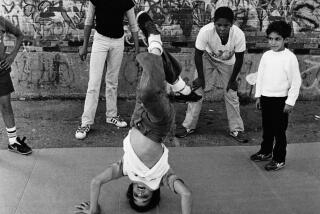Dutch Treat
- Share via
The syncopated sounds of children jumping and ropes slapping on a hardwood floor greet you before you reach the Veterans Memorial Building in Inglewood.
Inside, dozens of girls are busy honing their skills in a dazzling street sport that was brought to America by Dutch traders three centuries ago. Its name, coined by British settlers: double Dutch.
In groups of four, the children, ages 6 to 15, practice. A pair of girls grab the ends of two long ropes and twirl them quickly--alternately and in opposite directions--with an egg-beater motion.
Suddenly, one girl rocking back and forth on the sidelines hops in and starts jumping. Then another joins. Working in unison, the two jumpers begin a routine: crossing their legs, hopping on one foot, and spinning 360-degree turns with the precision of a ballet dancer’s pirouette.
Welcome to the headquarters of the Southern California Double Dutch League, an organization that provides a stimulating after-school activity for young girls, instills a spirit of competition and discipline, and could eventually lead to participation in international double Dutch tournaments.
“We are looking to take this as far as we can,” said T’Essa Varn, the group’s founder and head coach. “We hope to take this on the road from here to San Diego, from San Bernardino to Barstow.”
And, perhaps, to Norfolk, Va., where the 1997 international double Dutch tourney will be held in June.
In two years, Varn said, the young league has grown from an after-school program to an organization which sponsors tournaments with a dozen teams from the Inglewood area.
They now have a skilled exhibition squad ready to travel to nearby parks and schools to demonstrate the sport and draw new recruits.
Double Dutch is wildly popular in urban neighborhoods on the East Coast, particularly in the New York City area, where children have played it for generations. The Southern California league is hoping to make it a tradition here, too.
“Children here grow up playing hopscotch, tetherball and tag,” said Michelle Allen, another coach with the Southern California league.
“When we started, many of the kids didn’t have a clue about how to jump double Dutch, but with time and practice they have become very good.”
With the hope of developing strong enough talent to successfully compete on the national level, Varn and Allen traveled to Daytona Beach, Fla., last year to an American Double Dutch League convention, where they were certified in coaching and judging competitions.
Before they are ready for the big time, children must put in hours of practice. At the Veterans Memorial gym at Edward Vincent Jr. Park, the ropes turned by friendly partners were at times unforgiving.
“Ouch!” shouted Latasha Days, 9, as she bounced off the floor, tumbling with nervous energy after a fall. But she added, “This is fun.”
“I like to travel and make friends,” added Marlena McCoy, an exuberant 6-year-old, jumping high.
There are other lessons to be learned, said Mini Warren as she watched her daughter, Skye, practice.
“They learn self-discipline and dedication,” she said.
“The sport gives them a positive outlet for all [their] energy.”
*
The children, who practice twice a week, participate in competitions where they are judged in three categories--speed, ability to perform compulsory exercises and freestyle jumping.
The sport has come a long way from its early days as a recreational activity that Dutch traders brought to America.
When the British settlers arrived in New York City, they found that Dutch settlers there spoke two dialects.
“So the British began to describe anything they couldn’t understand as double Dutch,” said David Walker, co-author of a history of double Dutch.
Over the centuries it remained a popular street game, particularly in poor, densely populated neighborhoods, where clotheslines served as ropes.
*
As inner-city crime rates skyrocketed and the streets became less desirable as play areas, the sport began to fade.
But it received a burst of energy when Walker and others organized league competitions in 1973 as an activity for girls who didn’t have the same sports outlets as boys.
Some boys now play double Dutch too, although the sport remains largely one for young girls.
“Today double Dutch is an international sport,” Walker said. “A team from Japan won last year’s international competition at the Apollo Theater. You should have seen them, they were really good.”
The 40,000 participants nationwide in competitive double Dutch today have vastly altered the sport they inherited from colonial times, adding splits, push-ups and other acrobatic moves to a musical backdrop of rap and hip-hop.
There have been calls to make the sport a competitive event in the Olympics.
At the same time, the organizers have remained committed to some of their original goals.
“The theme is to rope, not [to use] dope,” said Janice Melvin, the national president of the American Double Dutch League.
(BEGIN TEXT OF INFOBOX / INFOGRAPHIC)
The Beat
Today’s centerpiece focuses on the Southern California Double Dutch League, a group that provides an organized after-school outlet for youngsters in a centuries-old street sport. For information on the league, including its May 3 competition in Inglewood, call (310) 412-5508.


